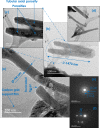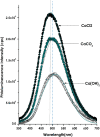Room temperature bio-engineered multifunctional carbonates for CO2 sequestration and valorization
- PMID: 37798317
- PMCID: PMC10556044
- DOI: 10.1038/s41598-023-42905-5
Room temperature bio-engineered multifunctional carbonates for CO2 sequestration and valorization
Abstract
This contribution reports, for the first time, on an entirely green bio-engineering approach for the biosynthesis of single phase crystalline 1-D nano-scaled calcite CaCO3. This was validated using H2O as the universal solvent and natural extract of Hyphaene thebaica fruit as an effective chelating agent. In this room temperature green process, CaCl2 and CO2 are used as the unique source of Ca and CO3 respectively in view of forming nano-scaled CaCO3 with a significant shape anisotropy and an elevated surface to volume ratio. In terms of novelty, and relatively to the reported scientific and patented literature in relation to the fabrication of CaCO3 by green nano-chemistry, the current cost effective room temperature green process can be singled out as per the following specificities: only water as universal solvent is used, No additional base or acid chemicals for pH control, No additional catalyst, No critical or supercritical CO2 usage conditions, Only natural extract of thebaica as a green effective chelating agent through its phytochemicals and proper enzematic compounds, room Temperature processing, atmospheric pressure processing, Nanoscaled size particles, and Nanoparticles with a significant shape anisotropy (1-D like nanoparticles). Beyond and in addition to the validation of the 1-D synthesis aspect, the bio-engineered CaCO3 exhibited a wide-ranging functionalities in terms of highly reflecting pigment, an effective nanofertilizer as well as a potential binder in cement industry.
© 2023. Springer Nature Limited.
Conflict of interest statement
The authors declare no competing interests.
Figures










References
-
- Franta B. Early oil industry knowledge of CO2 and global warming. Nat. Clim. Chang. 2018;8:1024–1025.
-
- Beck L. Carbon capture and storage in the USA: The role of US innovation leadership in climate-technology commercialization. Clean Energy. 2020;4(1):2–11. doi: 10.1093/ce/zkz031(2020). - DOI
Grants and funding
LinkOut - more resources
Full Text Sources
Other Literature Sources

